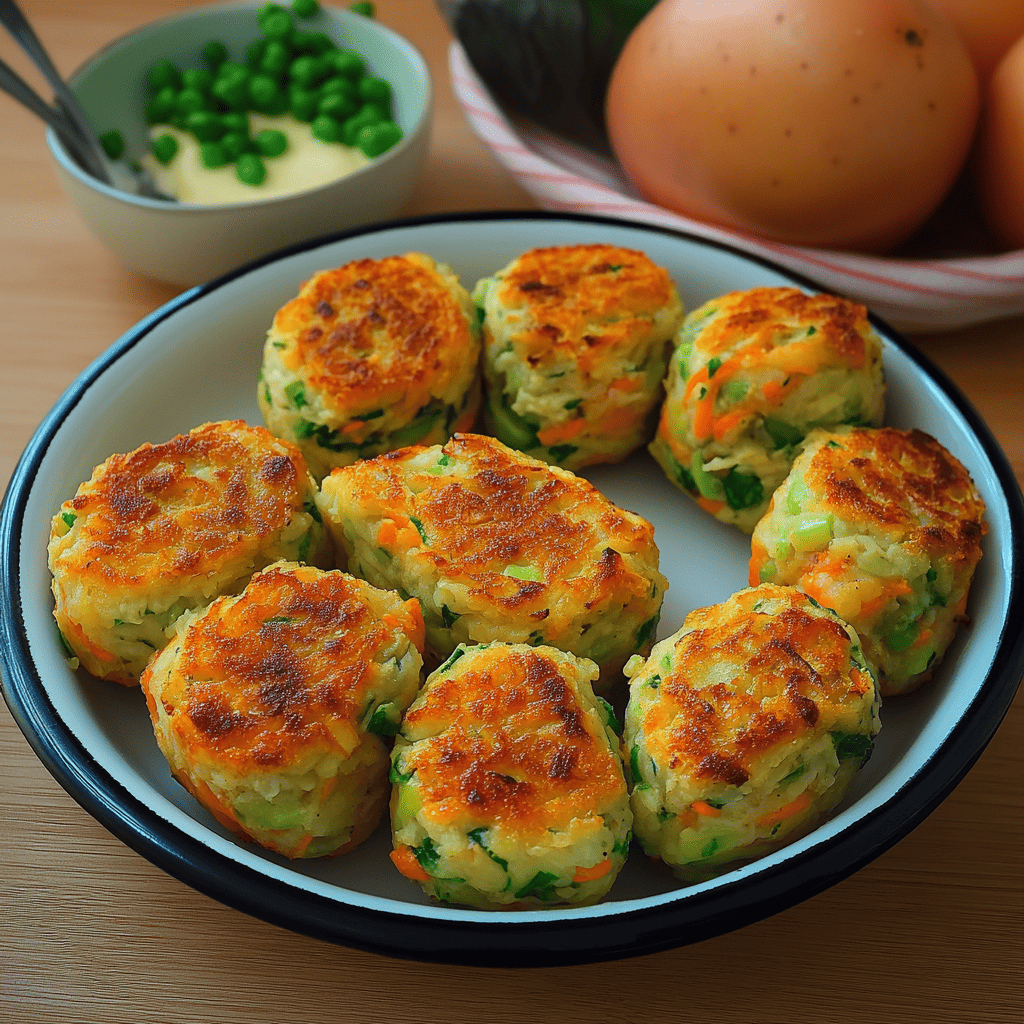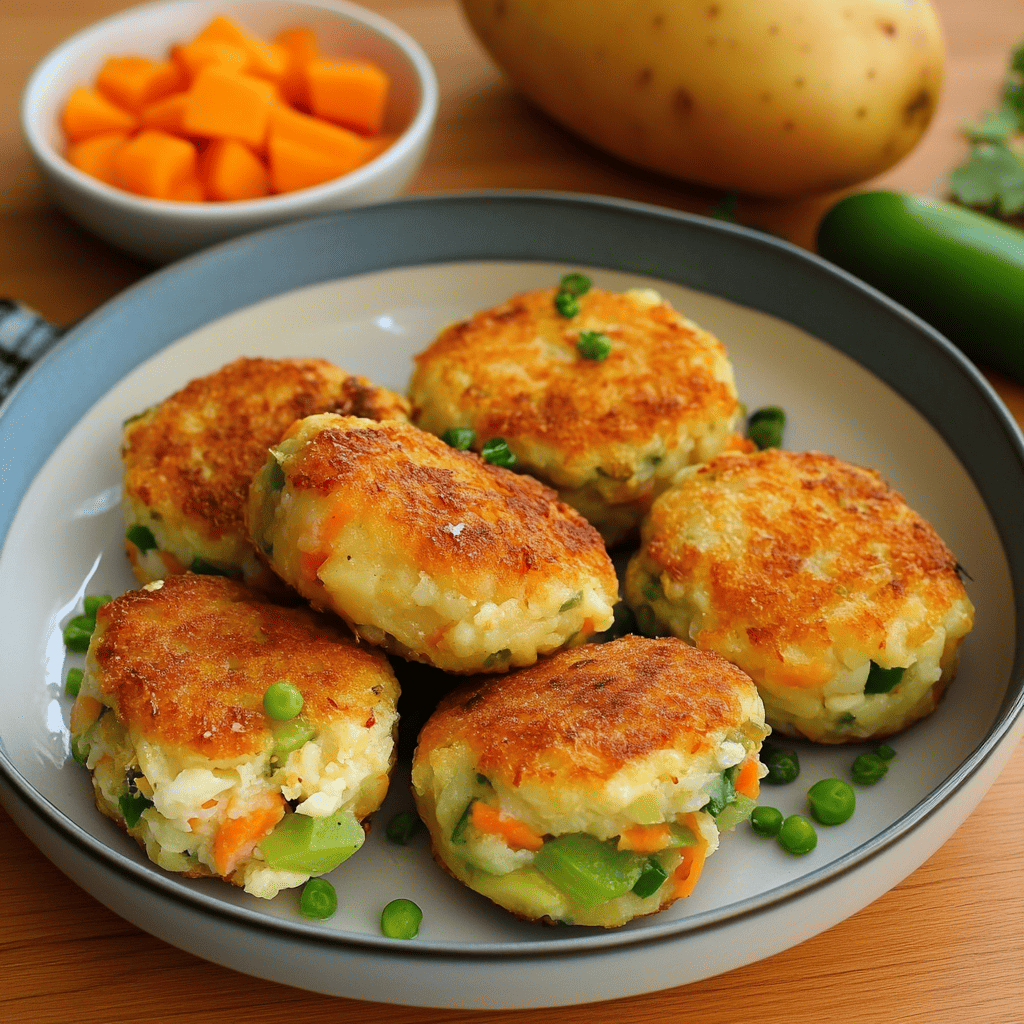Vegetable Meatballs
Introduction
Vegetable meatballs are a healthy, tasty, and versatile alternative for those looking to reduce their meat consumption or simply incorporate more vegetables into their daily diet. This recipe uses fresh, common ingredients like zucchini, carrots, and potatoes, combining them with oats for structure and grated cheese for an irresistible touch of flavor.
They’re ideal for vegetarians, children, or anyone looking for a nutritious, colorful, and easy-to-prepare meal. They can also be enjoyed on their own, accompanied by a yogurt or tomato sauce, or even inside a pita bread or wrap. Their crispy texture on the outside and tender on the inside make them a delicacy that combines both health and flavor.
History of Vegetable Meatballs
Meatballs have a long history dating back to many cultures around the world, where they were prepared as a convenient way to combine meat with grains, spices, and other accessible ingredients. However, with the passage of time and the advancement of food movements such as vegetarianism and veganism, an alternative and healthier version emerged: vegetable meatballs.
This dish has its roots in Mediterranean and Middle Eastern cuisine, where similar dishes such as falafel , made with chickpeas or fava beans, are traditionally prepared. With globalization and the expansion of plant-based diets, vegetable meatballs began appearing in cuisines around the world, adapted to locally available ingredients.
Zucchini, carrots, and potatoes, the main ingredients in this recipe, are vegetables common in many cultures and eras, appreciated for both their flavor and nutritional value. Incorporating oats as a binder instead of bread or refined flours also reflects modern trends toward more conscious and functional cooking.
Today, vegetable meatballs are an icon of healthy, sustainable, and affordable cooking. They’re served in vegetarian restaurants, sold in supermarkets, and, above all, prepared at home as a delicious way to reduce meat consumption without sacrificing the flavor and satisfaction of a nutritious, homemade dish.
Meatballs, in their most traditional form, have a long history dating back to ancient civilizations. Their origins are believed to be traced back to ancient Persia , where dishes similar to koftas—balls of minced meat mixed with spices—were common. Over time, this preparation spread throughout Europe, Asia, and North Africa, adopting different names and styles depending on the region.
As cultures adopted the concept of “dumplings,” they also began to adapt them to available ingredients. Thus, in the most humble kitchens or during times of scarcity, vegetable dumplings became an economical, practical, and nutritious solution.
During the 19th and 20th centuries, with the rise of vegetarianism in Europe and later veganism in the 21st, vegetable meatballs began to gain popularity, especially as a healthy alternative to meat-based versions. India and some Mediterranean countries already included versions of “koftas” or “falafel” made with legumes and vegetables long before they became globally known.
Today, vegetable meatballs are a staple in vegetarian, vegan, flexitarian, and healthy diets. They’re found in both home kitchens and haute cuisine restaurants, with recipes ranging from simple vegetable combinations to more sophisticated preparations featuring exotic spices, legumes, and whole grains.
Evolution in Different Cultures
- India: Malai kofta are vegetable meatballs served in a rich spiced sauce.
- Middle East: Falafels (made from chickpeas or fava beans) are a very popular form of fried meatball.
- Europe: Versions with potatoes, zucchini, and carrots are common in Mediterranean cuisine, especially in Spain, Italy, and Greece.
- Latin America: They are often prepared in stews or as a vegetarian option in modern restaurants and homes.
Contemporary interest
Today, vegetable meatballs represent more than just a meatless option: they are a creative and conscious culinary proposal that responds to new ways of eating that are more sustainable, ecological, and focused on personal well-being.
Their versatility has made them a staple on vegan and vegetarian menus around the world, and they are often paired with innovative sauces, whole grains, or even presented as veggie burgers.

Ingredients:
- 1 medium zucchini (grated)
- 1 medium carrot (grated)
- 1 medium potato (grated)
- 4 tablespoons of oatmeal (can be traditional or instant)
- 100 g grated cheese (can be mozzarella, parmesan or your favorite)
- 2 eggs
- 2 cloves of garlic (finely chopped)
- Fresh parsley to taste (chopped)
- Salt and black pepper to taste
- Olive oil (for frying or brushing if baking)
Detailed Preparation:
1. Prepare the vegetables:
- Wash the zucchini, carrot and potato well.
- Grate them with a coarse grater.
- Place the grated vegetables on a clean cloth or paper towel and squeeze out the excess liquid . This is important so the meatballs don’t become soggy.
2. Mix the ingredients:
- In a large bowl, place the grated and drained vegetables.
- Add the oats, grated cheese, chopped garlic, parsley, beaten eggs, salt and pepper to taste.
- Mix well until you have a smooth dough. The mixture should be pliable with your hands. If it’s too soft, add another tablespoon of oatmeal.
3. Form the meatballs:
- With slightly damp hands, form walnut-sized balls.
- You can flatten them slightly if you prefer a shape more like small hamburgers.
4. Cook:
Option A – Pan (faster):
- Heat a little olive oil in a frying pan over medium heat.
- Cook the meatballs in batches, browning them for 3-4 minutes on each side until golden brown and firm.
Option B – Oven (healthier):
- Preheat oven to 200°C (390°F).
- Place the meatballs on a baking sheet lined with baking paper.
- Brush them with a little olive oil.
- Bake for 20–25 minutes, turning halfway through.

Frequently Asked Questions:
- Can I bake them instead of frying them?
Yes! Baking them is a great option if you’re looking for a healthier version. - Can you freeze them?
Yes, you can freeze them already cooked. Let them cool completely and store them in an airtight container for up to 2 months. - What if I don’t have oats?
You can substitute them with breadcrumbs, chickpea flour, or even cooked quinoa. - Can they be made without cheese?
Yes, although cheese adds flavor and texture, you can omit it or use a vegan alternative. - What sauce goes well with these meatballs?
A lemon-yogurt sauce or a homemade tomato sauce is excellent.
Estimated Preparation Time:
- Preparation: 15–20 minutes
- Cooking:
- Pan frying: 8–10 minutes
- Oven: 20–25 minutes
- Estimated total: 30–35 minutes
Texture and Flavor:
- Texture: Crispy on the outside (if fried or baked well) and soft on the inside, with bits of vegetables that add texture.
- Flavor: Tasty and slightly sweet from the carrot and potato, with a salty touch from the cheese and a fresh aroma from the parsley and garlic.
Consumption Context:
- Ideal as a light lunch or dinner .
- It can be served with rice, salads, sauces, or in sandwiches (veggie burger type).
- Perfect for children and vegetarians .
- Suitable for taking to school or work.
Visual Aspect:
- Golden on the outside, with a colorful interior thanks to the vegetables.
- Attractive on the plate, especially if served with a fresh sauce or salad.
Curiosities:
- These meatballs are a great way to introduce more vegetables into your diet, especially for those who don’t readily consume them.
- They can be adapted with seasonal vegetables: spinach, grated broccoli, mushrooms, etc.
- Oats act as a natural binder, without the need for refined flour.
Approximate Nutritional Value (per serving of 3–4 meatballs):
- Calories: 180–220 kcal
- Protein: 9–11 g
- Fats: 8–10 g
- Carbohydrates: 20–25 g
- Fiber: 3–4 g
Values may vary depending on the type of cheese and cooking method.
Additional Benefits and Interesting Facts:
- Rich in fiber thanks to vegetables and oats: they aid digestion.
- Source of vegetable protein and calcium (if cheese is included).
- Low fat content when baked.
- Easy to adapt for vegetarian, gluten-free, or low-carb diets.
Other Useful Information:
- You can prepare the mix in advance and store it in the refrigerator for up to 24 hours before cooking.
- If you make a lot, store them cooked and reheat them in the oven or in a pan without oil to preserve the texture.

Conclusion
Vegetable meatballs are not only a light and nutritious option, but they also prove that plant-based cooking can be extremely tasty and satisfying. This recipe stands out for its simplicity, low-cost ingredients, and its ability to adapt to different dietary preferences.
Whether as a main dish, a side dish, or a snack, these meatballs provide fiber, plant-based protein, and essential vitamins and minerals. Making them is also a great opportunity to cook with the family and teach little ones to appreciate vegetables.
In short, these meatballs are a delicious example of how natural and homemade can go hand in hand with a balanced and creative diet. A recipe you’ll make again and again!

